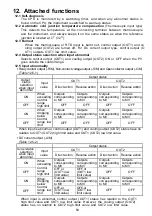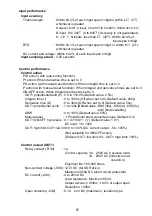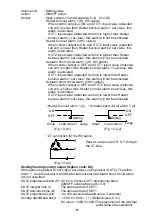
59
Alarm 2, Alarm 3, Alarm 4
The alarm type and action are the same as those of Alarm 1.
However, There are no outputs to these alarms, and Alarm Energized/Deenergized
action selection are not available.
Alarm status can be accessed by reading the status flag in serial communication.
Loop break alarm
Detects actuator trouble (heater burnout, sensor burnout).
This alarm uses common output terminals with Alarm 1, Heater burnout alarm/
Actuator short circuit alarm (W, W3 option).
When Heating/Cooling control output (DC option) is added
,
the Event output
becomes cooling output (OUT2). Therefore, Alarm 1, Loop break alarm and Heater
burnout alarm/Actuator short circuit alarm cannot be outputted.
Setting range
Loop break alarm time: 0 to 200 minutes (Default: 0 minutes)
Loop break alarm span: 0 to 150 ( ) or 0.0 to 150.0 ( )
(Default:
0 )
DC input: 0 to 1500
Output
Open collector: Control capacity, 0.1A 24V DC
Serial communication
Cable length
: 1.2km (Maximum)
Cable resistance: Within 50 (The terminator is not
necessary
or
120 or more on one side of the cable.)
Communication line
: Based on EIA RS-485
Communication method : Half-duplex communication
Communication speed : 9600bps (4800, 9600, 19200bps)
Selectable by DIP switch
Synchronous system
: Start-stop synchronous
Instrument number
: Address 0 (0 to 95), Selectable by two Rotary switches
Communication protocol: Shinko protocol, Modbus ASCII, Modbus RTU
Selectable by DIP switch
The contents set by the DIP and Rotary switch will take
effect when the power to the unit is turned on.
Therefore, settings changed after the power-on will not
take
effect.
Code form
: ASCII, binary (*)
Error detection
: Parity check, Checksum (LRC), CRC (*)
Error correction
: Command request repeat system
Data format
Start bit : 1
Data bit : 7, 8 (*)
Parity : Even, Odd, No parity (*)
Stop bit : 1
(*): Automatically selected upon selecting the
communication
protocol.






































